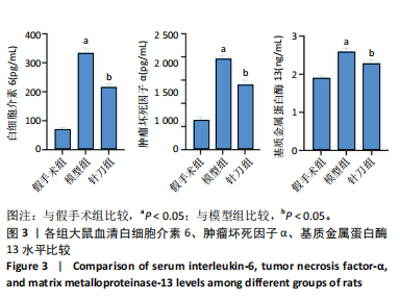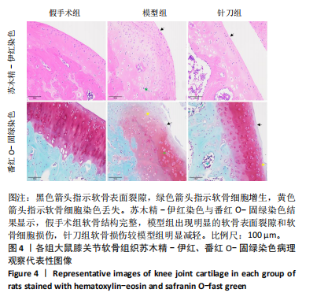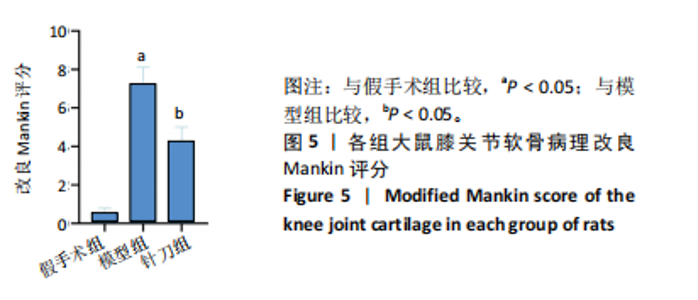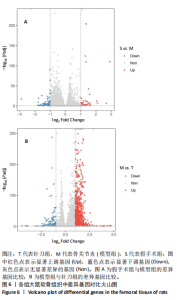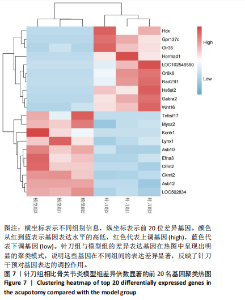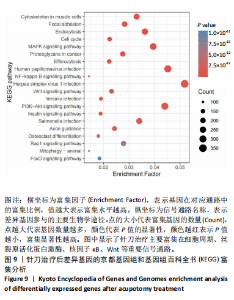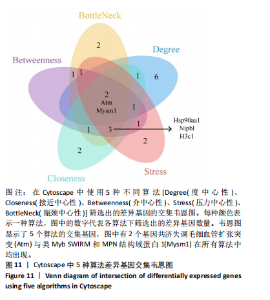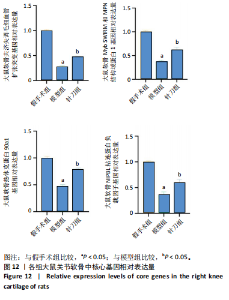Chinese Journal of Tissue Engineering Research ›› 2025, Vol. 29 ›› Issue (20): 4239-4248.doi: 10.12307/2025.722
Previous Articles Next Articles
Transcriptional profiling and experimental validation of acupotomy for knee osteoarthritis in rats
Liu Yantong1, Wang Shixuan2, Zhao Shuangli3, Wei Wei4, Wang Donghai2, Jiang Zongkun3, Liu Hongfei1
- 1Liaoning University of Traditional Chinese Medicine, Shenyang 110032, Liaoning Province, China; 2Department of Orthopedics I, 3Department of Orthopedics IV, 4Department of Orthopedics II, the Second Affiliated Hospital of Liaoning University of Traditional Chinese Medicine, Shenyang 110034, Liaoning Province, China
-
Received:2024-08-27Accepted:2024-10-16Online:2025-07-18Published:2024-12-20 -
Contact:Wang Shixuan, MS, Chief physician, Doctoral supervisor, Department of Orthopedics I, the Second Affiliated Hospital of Liaoning University of Traditional Chinese Medicine, Shenyang 110034, Liaoning Province, China -
About author:Liu Yantong, MD candidate, Physician, Liaoning University of Traditional Chinese Medicine, Shenyang 110032, Liaoning Province, China -
Supported by:National Famous Elderly Chinese Medicine Experts Inheritance Workshop Construction Project of the National Administration of Traditional Chinese Medicine, No. [2022]75 (to ZSL)
CLC Number:
Cite this article
Liu Yantong, Wang Shixuan, Zhao Shuangli, Wei Wei, Wang Donghai, Jiang Zongkun, Liu Hongfei. Transcriptional profiling and experimental validation of acupotomy for knee osteoarthritis in rats[J]. Chinese Journal of Tissue Engineering Research, 2025, 29(20): 4239-4248.
share this article
Add to citation manager EndNote|Reference Manager|ProCite|BibTeX|RefWorks
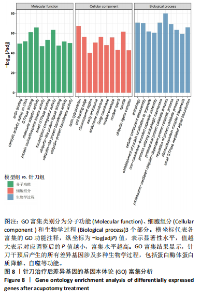
2.7.2 差异基因GO及KEGG富集分析 GO富集结果显示,针刀干预后产生的所有差异基因涉及多种生物学过程,包括蛋白酶体蛋白质降解、自噬等,见图8;KEGG富集结果显示,针刀干预调控多条信号通路,包括细胞周期、细胞内吞、丝裂原活化蛋白激酶、胞葬作用、核因子κB信号通路、Wnt信号通路、磷脂酰肌醇-3激酶/蛋白激酶B信号通路等,见图9。 2.8 蛋白质互作网络构建及关键基因筛选结果 针刀治疗后得到的差异基因导入在线String数据库,选择70个节点,640条边进行蛋白互做网络绘制,见图10。接下来,采用cytoHubba插件,运用Degree(度中心性)、Closeness(接近中心性)、Betweenness(介中心性)、Stress(压力中心性)、BottleNeck(瓶颈中心性)5种算法分别取各组排名前10的基因进行计算,见图11。最后,通过各算法取交集确定了2个关键基因,分别是共济失调毛细血管扩张突变(ATM)与类Myb SWIRM和MPN结构域蛋白1 (Mysm1)。 2.9 RT-qPCR检测结果 选取5种算法交叉映射的核心基因共济失调毛细血管扩张突变与类Myb SWIRM和MPN结构域蛋白1,并将韦恩图和蛋白质互作中与骨关节炎发病密切相关的热休克蛋白90α1与NIPNL粘连蛋白负载因子基因进行RT-qPCR检测。检测结果显示,与假手术组相比,模型组大鼠膝关节软骨共济失调毛细血管扩"

| [1] BOER CG, HATZIKOTOULAS K, SOUTHAM L, et al. Deciphering osteoarthritis genetics across 826,690 individuals from 9 populations. Cell. 2021;184(18):4784-4818.e17. [2] LI D, LI S, CHEN Q, et al. The Prevalence of Symptomatic Knee Osteoarthritis in Relation to Age, Sex, Area, Region, and Body Mass Index in China: A Systematic Review and Meta-Analysis. Front Med (Lausanne). 2020;7:304. [3] ØIESTAD BE, JUHL CB, CULVENOR AG, et al. Knee extensor muscle weakness is a risk factor for the development of knee osteoarthritis: an updated systematic review and meta-analysis including 46 819 men and women. Br J Sports Med. 2022;56(6):349-355. [4] HUNTER DJ, SCHOFIELD D, CALLANDER E. The individual and socioeconomic impact of osteoarthritis. Nat Rev Rheumatol. 2014;10: 437-441. [5] LV Z, YANG YX, LI J, et al. Molecular Classification of Knee Osteoarthritis. Front Cell Dev Biol. 2021;9:725568. [6] YAO Q, WU X, TAO C, et al. Osteoarthritis: pathogenic signaling pathways and therapeutic targets. Signal Transduct Target Ther. 2023; 8(1):56. [7] ALLEN KD, THOMA LM, GOLIGHTLY YM. Epidemiology of osteoarthritis. Osteoarthritis Cartilage. 2022;30(2):184-195. [8] JIANG W, CHEN H, LIN Y, et al. Mechanical stress abnormalities promote chondrocyte senescence - The pathogenesis of knee osteoarthritis. Biomed Pharmacother. 2023;167:115552. [9] PANCHAL NK, PRINCE SABINA E.Non-steroidal anti-inflammatory drugs (NSAIDs): A current insight into its molecular mechanism eliciting organ toxicities. Food Chem Toxicol. 2023;172:113598. [10] LUO D, ZHU H, LI S, et al. Mesenchymal stem cell-derived exosomes as a promising cell-free therapy for knee osteoarthritis. Front Bioeng Biotechnol. 2024;12:1309946. [11] LI H, ZHAO T, YUAN Z, et al. Cartilage lacuna-biomimetic hydrogel microspheres endowed with integrated biological signal boost endogenous articular cartilage regeneration. Bioact Mater. 2024;41: 61-82. [12] DMAHAJAN A, NENGROO MA, DATTA D, et al. Converse modulation of Wnt/β-catenin signaling during expansion and differentiation phases of Infrapatellar fat pad-derived MSCs for improved engineering of hyaline cartilage. Biomaterials. 2023;302:122296. [13] 朱汉章.针刀医学体系概论[J].中国工程科学,2006,8(7):1-15. [14] 潘胜莲,王庆来,方芳,等.微针刀治疗早中期膝骨性关节炎疗效观察及对IL-6、TNF-α、NO水平的影响[J].浙江中医杂志,2023, 58(4):281-282. [15] 孟锋,殷源,王天赋,等.小针刀治疗膝关节骨性关节炎疗效观察及对关节滑液TNF-α、MMPs表达的影响[J].河北医药,2017,39(2): 168-172. [16] 陈倩,黄小双,杨永晖,等.针刀调节Ca2+抑制膝骨关节炎大鼠软骨细胞凋亡的实验研究[J].中国中医基础医学杂志,2022,28(10): 1616-1623. [17] 贾小飞,冉丽,马小双,等.针刀调控软骨细胞自噬维持骨关节炎软骨细胞的稳态[J].中国组织工程研究,2024,28(34):5452-5457. [18] ZHENG X, LIN J, WANG Z, et al. Research of the analgesic effects and central nervous system impact of electroacupuncture therapy in rats with knee osteoarthritis. Heliyon. 2023;10(1):e21825. [19] WENG Q, CHEN Q, JIANG T, et al. Global burden of early-onset osteoarthritis, 1990-2019: results from the Global Burden of Disease Study 2019. Ann Rheum Dis. 2024;83(7):915-925. [20] 李树明,郭韧,陈平,等.针刀配合手法与非甾体抗炎药治疗膝骨关节炎疗效比较的系统评价与Meta分析[J].医学综述,2021, 27(22):4553-4559. [21] 许铛瀚,林煜翔,韦佳,等.调和阴阳针刀治疗膝关节骨关节炎:随机对照试验[J].中国针灸,2022,42(12):1351-1356. [22] ORTEGA MA, FRAILE-MARTINEZ O, DE LEON-OLIVA D, et al. Autophagy in Its (Proper) Context: Molecular Basis, Biological Relevance, Pharmacological Modulation, and Lifestyle Medicine. Int J Biol Sci. 2024;20(7):2532-2554. [23] LEE DY, BAHAR ME, KIM CW, et al. Autophagy in Osteoarthritis: A Double-Edged Sword in Cartilage Aging and Mechanical Stress Response: A Systematic Review. J Clin Med. 2024;13(10):3005. [24] LV X, ZHAO T, DAI Y, et al. New insights into the interplay between autophagy and cartilage degeneration in osteoarthritis. Front Cell Dev Biol. 2022;10:1089668. [25] WEN X, FANG G, LI H, et al. CircIRAK3 exerts negative feedback regulation on inflammation by binding to HNRNP U and destabilizing proinflammatory cytokine mRNA in osteoarthritis and chondrogenesis. Int J Biol Macromol. 2024;256(Pt 2):128453. [26] ARRA M, ABU-AMER Y. Cross-talk of inflammation and chondrocyte intracellular metabolism in osteoarthritis. Osteoarthritis Cartilage. 2023;31(8):1012-1021. [27] HORVÁTH E, SOLYOM Á, SZÉKELY J, et al. Inflammatory and Metabolic Signaling Interfaces of the Hypertrophic and Senescent Chondrocyte Phenotypes Associated with Osteoarthritis. Int J Mol Sci. 2023;24(22):16468. [28] KONG P, AHMAD R, ZULKIFLI A, et al. The role of autophagy in mitigating osteoarthritis progression via regulation of chondrocyte apoptosis: A review. Joint Bone Spine. 2024;91(3):105642. [29] FAZIO A, Di M, BRUNELLO M, et al. The involvement of signaling pathways in the pathogenesis of osteoarthritis: An update. J Orthop Translat. 2024;47:116-124. [30] LIZ, DAI A, YANG M, et al. p38MAPK Signaling Pathway in Osteoarthritis: Pathological and Therapeutic Aspects. J Inflamm Res.2022;15:723-734. [31] SHI Y, CHEN J, LI S, et al. Tangeretin suppresses osteoarthritis progression via the Nrf2/NF-κB and MAPK/NF-κB signaling pathways. Phytomedicine. 2022;98:153928. [32] CHENG J, LI M, BAI R. The Wnt signaling cascade in the pathogenesis of osteoarthritis and related promising treatment strategies. Front Physiol. 2022;13:954454. [33] TONG W, ZENG Y, CHOW D, et al. Wnt16 attenuates osteoarthritis progression through a PCP/JNK-mTORC1-PTHrP cascade. Ann Rheum Dis. 2019;78(4):551-561. [34] LEE J. Oxidative stress and the multifaceted roles of ATM in maintaining cellular redox homeostasis. Redox Biol. 2024;75:103269. [35] HE Y, ZISAN Z, LU Z, et al. Bergapten alleviates osteoarthritis by regulating the ANP32A/ATM signaling pathway. FEBS Open Bio. 2019; 9(6):1144-1152. [36] QUINTIENS J, DE R, CORNELIS F, et al. Hypoxia and Wnt signaling inversely regulate expression of chondroprotective molecule ANP32A in articular cartilage. Osteoarthritis Cartilage. 2023;31(4):507-518. [37] MATHIAS B, O’LEARY D, SAUCIER N, et al. MYSM1 attenuates DNA damage signals triggered by physiologic and genotoxic DNA breaks. J Allergy Clin Immunol. 2024;153(4):1113-1124.e7. [38] LE G, TOUZOT F, ANDRÉ-SCHMUTZ I, et al. An in vivo genetic reversion highlights the crucial role of Myb-Like, SWIRM, and MPN domains 1 (MYSM1) in human hematopoiesis and lymphocyte differentiation. J Allergy Clin Immunol. 2015;136(6):1619-1626.e5. [39] BAHRAMI E, WITZEL M, RACEK T, et al. Myb-like, SWIRM, and MPN domains 1 (MYSM1) deficiency: Genotoxic stress-associated bone marrow failure and developmental aberrations. J Allergy Clin Immunol. 2017;140(4):1112-1119. [40] YANG S, NIE T, SHE H, et al. Regulation of TFEB nuclear localization by HSP90AA1 promotes autophagy and longevity. Autophagy. 2023; 19(3):822-838. [41] GAO D, ZHU B, CAO X, et al. Roles of NIPBL in maintenance of genome stability. Semin Cell Dev Biol. 2019;90:181-186. [42] 马雯晴,张惠荣,刘辉,等.敲低NIPBL基因调控小鼠骨髓间充质干细胞向软骨的分化[J].中国组织工程研究,2023,27(10): 1477-1483. |
| [1] | Deng Keqi, Li Guangdi, Goswami Ashutosh, Liu Xingyu, He Xiaoyong. Screening and validation of Hub genes for iron overload in osteoarthritis based on bioinformatics [J]. Chinese Journal of Tissue Engineering Research, 2025, 29(9): 1972-1980. |
| [2] | De Ji, Suo Langda, Wei Yuchen, Wang Bin, Awangcuoji, Renqingcuomu, Cui Jiuzeng, Zhang Lei, Ba Gui. Comprehensive analysis of genes related to endometrial receptivity and alternative splicing events in northwest Tibetan cashmere goats [J]. Chinese Journal of Tissue Engineering Research, 2025, 29(7): 1429-1436. |
| [3] | He Guanghui, Yuan Jie, Ke Yanqin, Qiu Xiaoting, Zhang Xiaoling. Hemin regulates mitochondrial pathway of oxidative stress in mouse chondrocytes [J]. Chinese Journal of Tissue Engineering Research, 2025, 29(6): 1183-1191. |
| [4] | Liu Jianjian, Zhang Yan, Cui Zhiwei, Wang Dongfang, Liu Xu, Yang Shenglin, Chai Qian, Liu Fenglin. Isolation and protection of organs at risk by crosslinked sodium hyaluronate gel during brachytherapy [J]. Chinese Journal of Tissue Engineering Research, 2025, 29(4): 700-706. |
| [5] | Li Zhe, Li Ping, Zhang Chao, Guo Guangling. A network meta-analysis of efficacy of mesenchymal stem cells from different sources in treatment of premature ovarian failure animal models [J]. Chinese Journal of Tissue Engineering Research, 2025, 29(36): 7898-7908. |
| [6] | Yu Qinghe, Cai Ziming, Wu Jintao, Ma Pengfei, Zhang Xin, Zhou Longqian, Wang Yakun, Lin Xiaoqin, Lin Wenping. Vanillic acid inhibits inflammatory response and extracellular matrix degradation of endplate chondrocytes [J]. Chinese Journal of Tissue Engineering Research, 2025, 29(30): 6391-9397. |
| [7] | Fan Jiaxin, Jia Xiang, Xu Tianjie, Liu Kainan, Guo Xiaoling, Zhang Hui, Wang Qian . Metformin inhibits ferroptosis and improves cartilage damage in osteoarthritis model rats [J]. Chinese Journal of Tissue Engineering Research, 2025, 29(30): 6398-6408. |
| [8] | Zhou Ying, Tian Yong, Zhong Zhimei, Gu Yongxiang, Fang Hao. Inhibition of tumor necrosis factor receptor associated factor 6 regulates mTORC1/ULK1 signaling and promotes autophagy to improve myocardial injury in sepsis mice [J]. Chinese Journal of Tissue Engineering Research, 2025, 29(30): 6434-6440. |
| [9] | Wang Wanchun, , Yi Jun, Yan Zhangren, Yang Yue, Dong Degang, Li Yumei. 717 Jiedu Decoction remodels homeostasis of extracellular matrix and promotes repair of local injured tissues in rats after Agkistrodon halys bite [J]. Chinese Journal of Tissue Engineering Research, 2025, 29(30): 6457-6465. |
| [10] | Zhang Xin, Guo Baojuan, Xu Huixin, Shen Yuzhen, Yang Xiaofan, Yang Xufang, Chen Pei. Protective effects and mechanisms of 3-N-butylphthalide in Parkinson’s disease cell models [J]. Chinese Journal of Tissue Engineering Research, 2025, 29(30): 6466-6473. |
| [11] | Zhang Songjiang, Li Longyang, Zhou Chunguang, Gao Jianfeng. Central anti-inflammatory effect and mechanism of tea polyphenols in exercise fatigue model mice [J]. Chinese Journal of Tissue Engineering Research, 2025, 29(30): 6474-6481. |
| [12] | Hu Shujuan, Liu Dang, Ding Yiting, Liu Xuan, Xia Ruohan, Wang Xianwang. Ameliorative effect of walnut oil and peanut oil on atherosclerosis [J]. Chinese Journal of Tissue Engineering Research, 2025, 29(30): 6482-6488. |
| [13] | Zhang Jian, Cai Feng, Li Tingwen, Ren Pengbo. Fatigue gait recognition of athletes based on fish swarm algorithm [J]. Chinese Journal of Tissue Engineering Research, 2025, 29(30): 6489-6498. |
| [14] | Zhang Zihan¹, Wang Jiaxin¹, Yang Wenyi², Zhu Lei¹. Regulatory mechanism of exercise promoting mitochondrial biogenesis in skeletal muscle [J]. Chinese Journal of Tissue Engineering Research, 2025, 29(30): 6499-6508. |
| [15] | Wang Jianxu, Dong Zihao, Huang Zishuai, Li Siying, Yang Guang. Interaction between immune microenvironment and bone aging and treatment strategies [J]. Chinese Journal of Tissue Engineering Research, 2025, 29(30): 6509-6519. |
| Viewed | ||||||
|
Full text |
|
|||||
|
Abstract |
|
|||||


